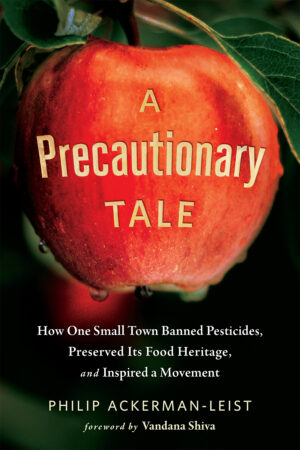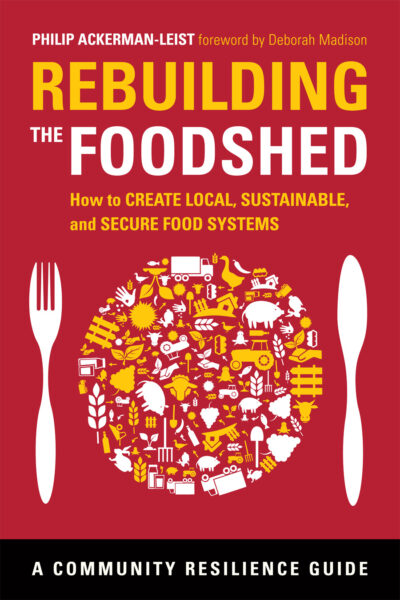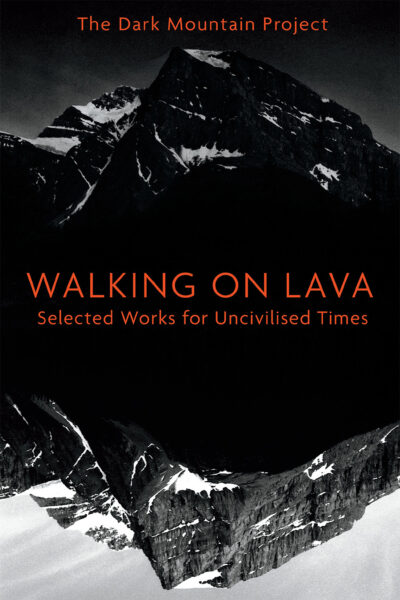How One Small Town Banned Pesticides: Freedom from Poison
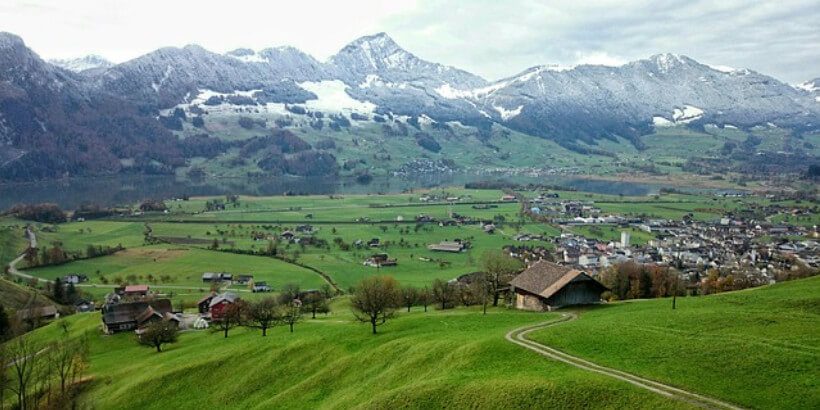
The recent uncovering of The Poison Papers—a collection of documents revealing years of apparent collusion between companies producing pesticides and other chemicals and regulatory agencies such as the EPA—shows just how difficult it is to stop corporate, agricultural, and other powerful interests from spraying dangerous chemicals, even when human health and the environment are at risk.
So how did a tiny town in Northern Italy prevail against big agriculture and make their town a pesticide-free zone?
The following excerpt is from A Precautionary Tale by Philip Ackerman-Leist. It has been adapted for the web.
Prefer audio?
Listen to the following excerpt from the audiobook of A Precautionary Tale.
“The movement for freedom from poisons in our food and agriculture is the most important freedom movement in our times. . . . Read the story of Mals to get inspired. And act.” —from the foreword by VANDANA SHIVA
No matter what time of day or night you might meet him, your lasting impression of Günther Wallnöfer is likely to be of a man in motion. Tall, lean, and equipped with a strong stride accustomed to craggy hills, he is adroit at leaping into and out of his tractor cab. The velocity of Günther’s local dialect matches his physical pace, and his hand gestures tend to be the only punctuation in his high-speed commentary. Chances are, if you’re talking to him, it’s while he’s doing something else, and his hands are constantly shifting between completing the task at hand and conveying a point of emphasis.
With an ever-present hat tilted to deflect the intensity of sun, wind, or cold from his receding hairline, Günther tends to keep his head down and his long gait in motion, focusing on everything that has to happen within the constraints of a twenty-four-hour day—a time frame obviously devised without any consideration for how much a dairy farmer has to achieve in the allotted time span. A dairy farmer anywhere in the world is up against the odds, but the steep slopes and short summers of the Alps make the life of a mountain farmer an even greater challenge. Günther’s fast clip, no matter the means of locomotion, is a constant reminder that there’s no time to slow down when you have to be one step ahead of what some call progress.
Inheriting a family business, much less a farm, can be as much a weight as it is a gift, and the local inheritance practices don’t make it any easier. As a young man, Günther began managing his family’s dairy farm in Laatsch. Unlike many other places in the region, the farmers in Laatsch and the other villages of Mals tended to have their houses and main barns inside the village proper, with the buildings huddled tightly around the inevitable spire of the village church. The surrounding fields around the inevitable spire of the village church. The surrounding fields, houses and main barns inside the village proper, with the buildings huddled tightly around the inevitable spire of the village church. The surrounding fields were used for hay, grains, vegetables, and pastures. It was, by design, a means of countering the vulnerability of the coveted valley with a tight collective identity and a stone-fortified armory to protect their livestock and winter stores.
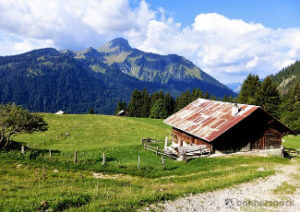 However, that design meant that each farm family, even up to this day, has managed a patchwork of very small, scattered fields, many of them less than an acre or two in size. Crops that needed to be brought to the barn for winter storage were grown close to the village, while most livestock were sent to the high mountain pastures for summer grazing so that hay from the nearby fields could be readily transported to the barn. This scattering of exceedingly small parcels, at least by modern standards, would ultimately play a key defensive role for the locals in their newest onslaught — one that no one could have predicted.
However, that design meant that each farm family, even up to this day, has managed a patchwork of very small, scattered fields, many of them less than an acre or two in size. Crops that needed to be brought to the barn for winter storage were grown close to the village, while most livestock were sent to the high mountain pastures for summer grazing so that hay from the nearby fields could be readily transported to the barn. This scattering of exceedingly small parcels, at least by modern standards, would ultimately play a key defensive role for the locals in their newest onslaught — one that no one could have predicted.
Günther was fortunate enough to inherit a relatively large assortment of fields. With 47 acres (19 ha) to divide among hay, pasture, grains, and even some vegetables, he had the ecological base to support about twenty- five milking cows and seven to eight calves, along with pigs and a small poultry flock. However, a sound ecological base doesn’t automatically translate into a manageable income.
Whereas his ancestors had struggled simply to subsist through the seasonal cycles of each year, Günther had to endure not just the Alps’ temperamental seasons but also the tempestuous markets that dictated whether he was in debt or on modest economic footing. As he gradually took over his family’s farm, he continued to manage it conventionally and sell to the local dairy processor, much as his father had. However, the consistently meager economic return created by the combination of market plunges and increased costs forced him to question whether he would be the last in his family’s long line of diversified farmers if he kept going that route.
That long lineage stretched far beyond just three or four generations. Archaeologists have discovered the relics of several settlements in the area that date back as far as the Stone Age. They have even unearthed a variety of grains in the carbonized remains, including some strains that are still grown in the area for the hearty traditional breads and dishes. The rich diversity of the Upper Vinschgau was coveted long before it ever appeared on a map.
After too many nights long on worry and short on sleep, Günther eventually came to the conclusion that the only way he could ensure the economic viability of his family’s farm was to certify it as organic and tap into those more lucrative and stable markets, earning him 20 to 30 per-cent more for his milk. He could also diversify his products, adding organic poultry, grain, and vegetables, and capitalize on those added income streams. In 2001 he went bio (pronounced BEE-oh) and became certified organic. In the end, it wasn’t such a radical decision: Going organic was, for him, a return to the traditional ways. He would be managing livestock, crops, and the landscape the same way his ancestors did. It turned out, however, that his decision to go organic put him directly in the path of progress. Big Apple was on its way up the Vinschgau Valley, and he could see it coming. He just didn’t realize how quickly he would be surrounded.
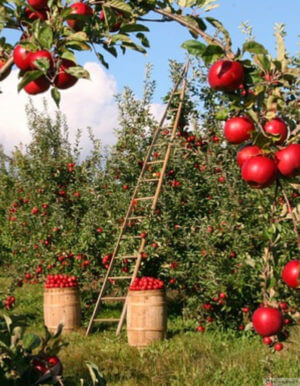 The Vinschgau Valley, known by the Italians as Val Venosta, forms the westernmost corner of the autonomous province of South Tirol in Italy. The driest valley in the Alps, with an average of 16 to 20 inches (40–50 cm) of rain and nearly 300 days of sun per year, it is ideal for growing apples, grapes, cherries, pears, and other fruits. Since moisture and cloudy weather create optimal conditions for the spread of plant diseases, the sunny slopes, good air drainage, and deep valley soils in the Vinschgau combine to create a Paradise for fruit growers. And nothing is more tempting than an apple in Paradise.
The Vinschgau Valley, known by the Italians as Val Venosta, forms the westernmost corner of the autonomous province of South Tirol in Italy. The driest valley in the Alps, with an average of 16 to 20 inches (40–50 cm) of rain and nearly 300 days of sun per year, it is ideal for growing apples, grapes, cherries, pears, and other fruits. Since moisture and cloudy weather create optimal conditions for the spread of plant diseases, the sunny slopes, good air drainage, and deep valley soils in the Vinschgau combine to create a Paradise for fruit growers. And nothing is more tempting than an apple in Paradise.
While apples had a long history in the lower reaches of the Vinschgau Valley, they weren’t a big part of the traditional agricultural economy of the Upper Vinschgau. Because neither climate nor custom was conducive to growing apples in the eleven high-elevation villages of Mals, which range from 3,300 to 5,600 feet (1,000–1,700 m) in elevation, inhabitants of the region have relied upon livestock and crops well adapted to the intensity of weather and topography in the area at least since the Stone Age.
Mals is flanked on three sides by some of the highest mountains in the South Tirol, including the Ortler, the highest at 12,812 feet (3,905 m). The Adige River gathers its force from the downward-flowing waters of the surrounding mountains and pushes its way eastward through the valley and into the city of Meran, then veers southward toward Verona, eventually dumping into the Adriatic Sea. Despite the constraints of elevation, the inhabitants of the higher reaches of the Vinschgau long ago discovered ways in which to optimize slope and turn it into a useful variable for agriculture.
Cattle, goats, sheep, and even pigs traditionally followed the greening of the grass as it gradually moved up beyond the tree line and then back down, essentially following the rise and fall of the mercury through the course of the year. With much of the livestock sent to the high pastures, farmers could use the lower fields to grow grains, vegetables, and the linch-pin of the system: hay. In such a risky growing environment, farmers grew fruits for subsistence but not extensively for commercial purposes. Milk products, cold-hardy vegetables, and grains were a better bet for market. Even as modern markets evolved and fruits began commanding higher prices and better incomes than the other high-elevation products, the farmers of the Upper Vinschgau generally stuck by the traditions and conservative wisdom that had served them well for millennia.
That aversion to risk began to melt away not too long ago, virtually in sync with the shrinking of the glaciers in the mountains high above the valley. Suddenly a warming climate and hardier fruit varieties conspired to create not just new but also more lucrative market opportunities for farmers. The sweet possibilities were hard to resist, and in the course of a few short years locals found themselves watching what looked like a big game of tic-tac-toe progress up the valley, with farmers weighing their options before filling the patchwork grid of open fields with trellised apples, grapes, and cherries. Günther was just one of many farmers about to find themselves caught in a game they’d never agreed to play.
Emboldened by the ever-earlier retreat of winter, Big Apple’s avant-garde began to brazenly take up position in a few fields in Mals. In a township covering just over 90 square miles (233 sq. km), it would seem that there was plenty of land to spare, and a few apple and cherry orchards wouldn’t matter. However, fruit growers and livestock farmers both preferred the flatter fields in the broad valley floor, and those areas were in limited supply.
In 2010 Günther noticed the first concrete posts and trellis wire delivered to his neighbor’s adjacent fields. Soon the reverberations of the post driver seemed to pound the fear of what was coming deeper and deeper into his consciousness. Workers came in to stretch the trellis wires and anchor them to the posts before installing the drip irrigation system. Only after the engineering was complete did the planting begin. More workers planted the young apple whips about 3 to 9 feet (1–3 m) apart so that each row of apples would become a highly efficient production line: Pruning, anchoring, watering, spraying, and harvesting could all be done with relative ease and consistency.
Although Günther wasn’t so keen on the intrusive aesthetics of the intensive trellising system, that was the least of his worries. The real intrusion wasn’t visible, but it put everything that he had worked so hard to build at risk.
As Günther and his cows wove their way through Laatsch, a beeping horn stopped him. He turned around, spreading his arms to slow the bovine promenade behind him, and let the car slip by before he and his cows stepped back into the main thoroughfare for their jaunt from the barn to pasture. The driver had Swiss plates and a business suit. Someone in a rush to make money, he surmised, while he headed out to his fields to seal his own financial fate in several plastic bags.
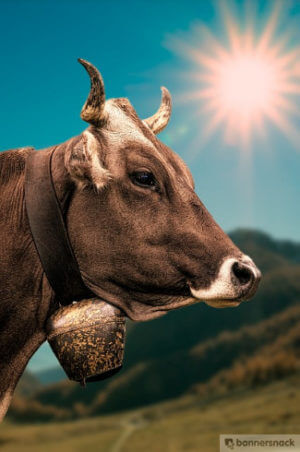 He crossed the street, with the boss cow and her entourage following. Then he stepped aside and let her lead the herd—she knew where she was headed—while he waited for the inevitable straggler, gave her a firm slap on the haunch, and watched her leap forward to catch up with the rest. Günther then sprinted along the edge of the paved bike path and past the last of the ambling cows to the pasture gate, where the cows were calmly filing in before rushing to the new strip of ungrazed grass that he had opened up earlier that morning. His portable electric fencing allowed him to carefully manage his small pastures, maximizing their regrowth and nutritional value by giving the cows access to fresh grass every day but preventing them from overgrazing any one spot.
He crossed the street, with the boss cow and her entourage following. Then he stepped aside and let her lead the herd—she knew where she was headed—while he waited for the inevitable straggler, gave her a firm slap on the haunch, and watched her leap forward to catch up with the rest. Günther then sprinted along the edge of the paved bike path and past the last of the ambling cows to the pasture gate, where the cows were calmly filing in before rushing to the new strip of ungrazed grass that he had opened up earlier that morning. His portable electric fencing allowed him to carefully manage his small pastures, maximizing their regrowth and nutritional value by giving the cows access to fresh grass every day but preventing them from overgrazing any one spot.
A cow’s milk production is directly correlated to what she eats, and what she eats depends upon the farmer’s management. There was only one thing more important to Günther than fresh grass: high-quality hay. Fresh grass in lush pastures made him money, but good hay meant survival. For his livestock, it was the bridge between seasons; for his family it was the difference between a healthy future and financial ruin.
Günther made his way up to where his neighbor’s new apple trees bordered one of his hayfields. Were it not for the apple trees on one side and the hay meadow on the other, the boundary between the two parcels probably wouldn’t be discernible to the ordinary passerby. He had just cut the leafy mixture of grasses, legumes, and other broad-leafed herbs. It was a task he usually enjoyed, watching the diverse green bounty fall to the ground in tidy swaths and feeling like he had winter under control. Most years he would pass through each hay meadow three times. Although it varied by year, the first cut tended to have more grasses and carbohydrates while the latter cuts usually had more legumes and higher protein levels. With the variety of cuttings, Günther could give his cows, calves, steers, and other livestock what best fit their nutritional needs. The one thing that couldn’t vary, however, was whether the hay was pesticide-free.
It was that concern that had slowed his stride and distracted him in his chores all morning. He made his way up through the hayfield, kicking the toppled grasses and legumes to check their dryness, wishing that this year’s crop would give him the age-old sense of security he’d always known before. He walked toward to his first sampling location, shaking his head with frustration at the laughable 10-foot (3 m) buffer between his hay and the outer row of apples, a distance that was supposed to protect his hay from his neighbor’s pesticides.
He knelt down to collect the first sample and put it in one of the sterile plastic bags he’d brought with him. He was nervous enough about the results, but to make matters worse, he had to pay 250 euros per bag (about $300 at the time) out of his own pocket simply to have each bag tested for pesticide residues—pesticides used by someone else.
He felt like he was gathering the tea leaves for his entire future and sending them off to a white-coated technician who would place them in a laboratory cocktail and read them before sending him a verdict on the future of his farm. Whether or not he could make sense of the analysis when it came was another question. He was accustomed to dealing with tons, hectares, and liters, but “parts per million” and “tolerances” were things he and other organic farmers had always intended to avoid.
Hay had long been the linchpin of Tirolean agriculture. Günther describes it as “the most important thing that we have here.” Whereas some other areas of the South Tirol have higher levels of protein in their hay, the Upper Vinschgau is comparable to a semiarid steppe region, with a diversity of herbs stemming from the dry substrate. Those herbs create what Günther and others there consider pastures and hay meadows of an exceptional quality that are essential to the healthy livestock of the region. If he lost his organic certification due to a confirmation of pesticide residues in his hay, he would lose more than his feed. He would also have to give up his farm and the traditional farming practices that were the foundation of the local culture. And he would simply be the first domino to fall.
Any sense of solitude in the Alps usually comes by way of feeling diminutive in the presence of mountains. In a small Alpine village, however, one seldom feels alone. But when Günther answered the phone on that fateful day and heard the voice of the toxicologist deliver the results of his hay sample analyses, he had never felt quite so isolated, despite being in the middle of the village that had nurtured him for his entire life. There was no silver lining in the report. Every sample that he had sent in had tested positive for residues of multiple pesticides. He’d been kicked and rammed around by cattle his whole life, but he’d never been knocked breathless by a phone call. The follow-up email detailing the results only added to the darkening reality.
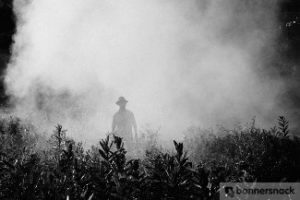 The lab results might have been conclusive, but Günther felt like they generated more questions than answers. How was he going to explain the results to his neighbors who had sprayed the pesticides? What was he going to do with the contaminated feed? What substances were detected and what did they mean for the health of his animals and his land?
The lab results might have been conclusive, but Günther felt like they generated more questions than answers. How was he going to explain the results to his neighbors who had sprayed the pesticides? What was he going to do with the contaminated feed? What substances were detected and what did they mean for the health of his animals and his land?
Günther spent the rest of the day and most of the night on the phone and sending out emails. Even if it was unclear to him at the time, this was the first sign that his life as a dairy farmer was about to change, and he was about to be dialed into more people and networks than he’d ever imagined. Phone calls, emails, and letters were about to fill every narrow crevice of his daily schedule, and the village’s image of him as the gangly young farmer with the ever-present hat would soon include him holding his cell phone to his ear.
However, none of the conversations helped alleviate the feelings of isolation and fear. If anything, the consequences of the analyses were becoming ever clearer, even if they were bewildering. His first call after receiving the results was to his certifier at Bioland, the organic cooperative to which he belonged. He’d long believed that the membership fees he paid to the cooperative were ultimately an investment in the betterment of his own farm. It wasn’t simply a contractual relationship. Bioland also held farm tours and seminars and offered a social network for farmers who too often felt like they were going it alone in their farming ventures. Günther was about to find out if Bioland also provided a safety net for its members.
It didn’t feel so positive at first. His certifier at Bioland informed him that in order to keep his organic certification—the keystone to his farm’s economic success at the moment—he would have to dispose of the entire first cutting of hay that he’d harvested in areas adjacent to the new orchards. Winter had never looked bleaker.
However, summer seemed just as bad. He would have to take samples from his next two hay harvests, too, and it seemed all too likely that they would also test positive. To boot, he would have to pay for even more analyses while also buying organic hay from another farmer at a premium price, if anyone had any surplus for sale. It was a coveted commodity.
Finally, there was the ironic reality that illuminated the absurdity of the whole situation. In order to maintain his certification, he had to dispose of the tainted hay crop and document that it had left the farm. He actually had to find a buyer for it—someone who would take the hay, despite the fact that it contained pesticide residues. Ordinarily he would walk out of his house and be down at the local bar, the Gasthaus Lamm, to have a drink to commiserate with his friends. For the time being, though, he had to figure out his best course of action. A turf battle in a small town is guaranteed to get personal, but to Günther the issue seemed much bigger than him alone. And if it didn’t get resolved now, in a good way, he was sure that it would turn into an ugly battle that would stretch far past his generation.
The people of Mals had just elected a new young mayor who seemed much different from the usual politicians in the South Tirol. Günther decided to reach out to him first to see if he had any insights. Little did he know that he was inviting the mayor to join him in careening down a path that neither could have expected—in fact, it would turn out to be a path that no town had ever gone down before.
A striking but soft-spoken figure, Ulrich Veith—known by most locals as Uli—isn’t anyone’s image of a stereotypical mayor. Perfectly comfort-able in a crisp Italian suit and fashionable footwear, he can play the part of mayor in traditional table-and-chair ways. However, he seems most at home when he is casually walking the streets of Mals, greeting virtually everyone he bumps into with a fitting salutation, be it in Tirolean dialect, Italian, or on one knee, for the smallest of his patrons.
Though he’s in his mid-forties, Uli’s trim physique and casually groomed wavy hair give the impression that he is a decade younger. His slightly bronze, fit appearance isn’t an artifice created in a spa but rather on the hiking paths, bike trails, and ski slopes in and above Mals, often in pursuit of his super-athlete wife, Marian, with their young son in tow. Neither unaware of custom nor flippant about cultural expectations, Uli is nonetheless just as likely to appear at an appointment in fashionable athletic wear as he is in a suit. He always seems ready to take advantage of the best that Mals has to offer in year-round outdoor activities—or perhaps he is in constant training to keep up with Marian, an avid rock climber and mountain biker who is at least as nontraditional in her mother-athlete role as Uli is in politics.
After more than a decade of traveling the world for business, Uli had returned to his native Mals with no real political aspirations—in fact, he was not even registered with a political party at the time. He did, however, have a deep desire to see the Upper Vinschgau make its way forward into the twenty-first century, building upon the best the region had to offer. That desire eventually led him to a victorious run for mayor of Mals in 2009, and he was eager to represent his townspeople as well as he possibly could. So when Günther called to set up a meeting about a problem he was having, Uli immediately invited him to his office in the town hall.
You would be hard-pressed to find a better measure of contrasts in Mals than Uli and Günther. Günther will show up to almost any function in a T-shirt, work pants, and heavy leather farm boots, while Uli will appear looking fresh and dapper, if not aerodynamic, in his perfectly tailored suit or formfitting running outfit. Günther’s handshake will feel like he’s about to squeeze milk out of your four fingers while Uli’s firm but uncallused squeeze is a testament to his habit of making acquaintances from all walks of life. In a moment of uncertainty, Günther might run his hand over the tingle of his buzz cut while Uli slips his hand through his wavy hair during a pensive pause. Günther will insist that he can speak only Tirolean dialect and high German while Uli will shift fluently between both before jumping in with English or Italian.
But they always shared one thing in common: a deep passion for what they both dubbed a sustainable future for Mals. Before long, they would both add another descriptor to the future they envisioned for their town—healthy.
Dairy farmers don’t tend to embrace politicians or meetings very readily, but as far as he could tell, Günther had limited options for people who would comprehend the full scope of the dilemma, much less have the means to help address the looming issues. When he met with Uli, he described the problem as succinctly as he could, framing it as not just his issue but a quandary facing all of the 5,300 citizens in the eleven villages of the Mals township.
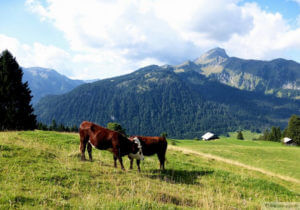 With the small field sizes that dominated the Mals landscape— usually just a few acres—and the renowned Vinschgerwind, the legendary wind of the valley blowing for days or weeks at a time, the drifting of pesticides applied by any single farmer onto other farmers’ fields was inevitable. In addition, with the town’s waterways, bike paths, playgrounds, and schoolyards in such close proximity to fields that might be converted to intensive fruit production, the health of the people and the environment was in peril.
With the small field sizes that dominated the Mals landscape— usually just a few acres—and the renowned Vinschgerwind, the legendary wind of the valley blowing for days or weeks at a time, the drifting of pesticides applied by any single farmer onto other farmers’ fields was inevitable. In addition, with the town’s waterways, bike paths, playgrounds, and schoolyards in such close proximity to fields that might be converted to intensive fruit production, the health of the people and the environment was in peril.
Mals was going green but the future was looking gray, at best. With organic farms, traditional grain growing, bike touring, agritourism, herbal products, and even the region’s first organic hotel all in the works and on the rise, an influx of pesticide-dependent fruit “plantations” could mean the collapse of so many collective dreams.
Günther was adamant: Farmers should be able to manage their farms the way they wanted to, but only up to the point at which their decisions negatively impacted others. If the situation he faced was just the beginning, which certainly seemed to be the case, then any hope of Mals being the last regional bastion of sustainable and diversified agriculture seemed doomed.
Uli concurred and agreed to help find a solution. Neither quite realized what they were agreeing to. They were about to challenge the way things were done not just in the orchards and vineyards of the South Tirol but also in the ballot box. Stirring things up is a messy business.
Recommended Reads
Recent Articles
Garlic mustard: while known as “invasive,” this plant can be consumed in its entirety and has great nutritional value. Plus, the garlic-flavor is a perfect addition to any recipe that calls for mustard! The following are excerpts from Beyond the War on Invasive Species by Tao Orion and The Wild Wisdom of Weeds by Katrina…
Read MoreEveryone loves a refreshing, fermented, nutritious drink…even your garden! Take your fermentation skills out of the kitchen and into the garden by brewing fermented plant juice. The following is an excerpt from The Regenerative Grower’s Guide to Garden Amendments by Nigel Palmer. It has been adapted for the web. How to Make Fermented Plant Juice Fermented…
Read MorePeregrine falcons, while known as predators, are essential to our environment. These stunning birds have a rich history, an interesting present, and an uncertain future. The following is an excerpt from Feather Trails by Sophie A. H. Osborn. It has been adapted for the web. Who Are Peregrine Falcons? Though relatively uncommon wherever it occurs,…
Read MoreWant to see your crops thrive this upcoming growing season? The key is in soil fertility and health. Spend time maintaining your soil’s health to guarantee bigger and better crops come harvest time! The following is an excerpt from No-Till Intensive Vegetable Culture by Bryan O’Hara. It has been adapted for the web. What Is Soil Fertility?…
Read MoreMany know the effects of catnip on our feline friends, but few realize that catnip has medicinal effects for humans. From stomach aches to reducing fevers, catnip is a versatile herb with many benefits. The next time you grow this plant for your cat you may end up taking a few cuttings for yourself! The…
Read More

